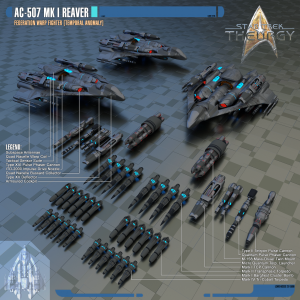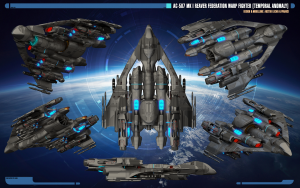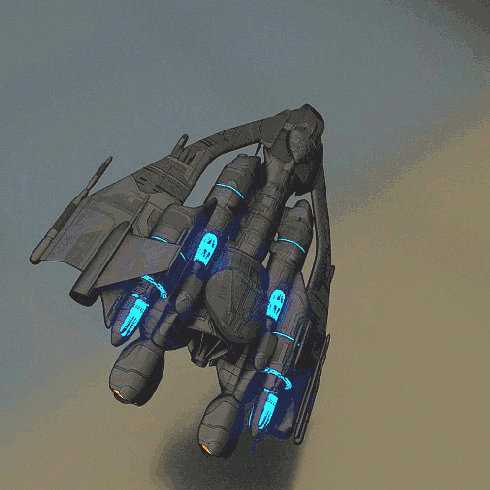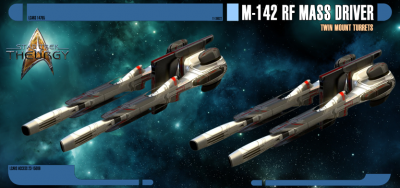AC-507 Mk I Reaver: Difference between revisions
From Star Trek: Theurgy Wiki
Auctor Lucan (talk | contribs) |
Auctor Lucan (talk | contribs) |
||
| Line 120: | Line 120: | ||
==== Micro Quantum Torpedo Launchers ==== | ==== Micro Quantum Torpedo Launchers ==== | ||
[[File:Torpedo-Launcher-Reaver-Details.png|left|150px]]Additional, wing-mounted torpedo launcher that hold 28 micro quantum torpedoes per launcher. Recommended to mount two of these in order to balance the fighter properly. This means that the hard-point option of additional torpedo launchers hold 56 additional mirco-torpedoes since the Reaver itself doesn't carry any as standard internal armament. | [[File:Torpedo-Launcher-Reaver-Details.png|left|150px]]Additional, wing-mounted torpedo launcher that hold 28 micro quantum torpedoes per launcher. Recommended to mount two of these in order to balance the fighter properly. This means that the hard-point option of additional torpedo launchers hold 56 additional mirco-torpedoes since the Reaver itself doesn't carry any as standard internal armament. | ||
==== Mk IV Tri-Cobalt Torpedo ==== | ==== Mk IV Tri-Cobalt Torpedo ==== | ||
| Line 130: | Line 129: | ||
X<br> | X<br> | ||
==== | ==== Mk I Barghest Cluster Bomb ==== | ||
[[File: | [[File:Barghest-Cluster-Bomb.png|left|150px]]Similar to the nature of a photon torpedo. Essentially, this is a photon torpedo filled with several micro torpedoes. Once the torpedo comes in contact with an enemy or a surface, it detonates and fragments into smaller torpedoes, which spread from the point of impact, also exploding on impact, resulting in a large pattern of torpedo detonations. Deployed right, this hard-point may cause severe damage when scattered upon enemy shield impact. The torpedo snap open by spring-force, and both the arming and the fuze is pilot-controlled by either manual or automatic settings. It can be armed prior to discharge or scattered by manual command. | ||
Similar to the nature of a photon torpedo. Essentially, this is a photon torpedo filled with several micro torpedoes. Once the torpedo comes in contact with an enemy or a surface, it detonates and fragments into smaller torpedoes, which spread from the point of impact, also exploding on impact, resulting in a large pattern of torpedo detonations. Deployed right, this hard-point may cause severe damage when scattered upon enemy shield impact. The torpedo snap open by spring-force, and both the arming and the fuze is pilot-controlled by either manual or automatic settings. It can be armed prior to discharge or scattered by manual command. | |||
==== Twin Mount Turrets ==== | ==== Twin Mount Turrets ==== | ||
Revision as of 00:35, 23 July 2016
UNDER CONSTRUCTION
The Mk I Reavers were the kind of warp fighters that were commissioned to the USS Calamity.
Fighter Demonstration
Production History
[Insert Data]
External Hard-point Options
The Mk I Reaver can hold up to external wing-mounted hard points during missions, listed below.
Micro Quantum Torpedo Launchers
Additional, wing-mounted torpedo launcher that hold 28 micro quantum torpedoes per launcher. Recommended to mount two of these in order to balance the fighter properly. This means that the hard-point option of additional torpedo launchers hold 56 additional mirco-torpedoes since the Reaver itself doesn't carry any as standard internal armament.
Mk IV Tri-Cobalt Torpedo
X
X
X
X
X
X
Mk I Barghest Cluster Bomb
Similar to the nature of a photon torpedo. Essentially, this is a photon torpedo filled with several micro torpedoes. Once the torpedo comes in contact with an enemy or a surface, it detonates and fragments into smaller torpedoes, which spread from the point of impact, also exploding on impact, resulting in a large pattern of torpedo detonations. Deployed right, this hard-point may cause severe damage when scattered upon enemy shield impact. The torpedo snap open by spring-force, and both the arming and the fuze is pilot-controlled by either manual or automatic settings. It can be armed prior to discharge or scattered by manual command.
Twin Mount Turrets
Twin Dual Cannon guns utilising an ammunition replicator to create 30mm Osmiridum shells. These shells are suspended in a small warp field bubble to render them nearly weightless before being electromagnetically propelled at a speed near mach 15 with a rate of up to 1000 rounds per minute assuming all 4 cannons are being fired. Devastating against soft targets as well as being effective against armours of nearly all types. However it is ineffective against shields, and its projectiles can be easily reflected via standard deflector arrays. The weapon can be placed in a fixed forward position or can be set to automatically track subsonic targets for fire, though it proves to be ineffective at automatically tracking fast moving small targets. It can hit large targets moving at high speeds but not with the same precision as expected with slow or fixed targets. Designed for aerial and suborbital assault on non-shielded Terrestrial targets, deep space strikes against bases, and aerial support of ground operations (see below for more information).
M-142 RF Mass Driver Twin Mount Turrets
The M-142 RF Mass Driver Twin Mount is a set of two dual-mass driver semi-automated turrets. These lethal devices are hard-point mounted on the undersides of the impulse drives, and in their default position they face forward. Aimed similarly to the micro-torpedo launchers and Pulse phaser cannons on the Valkyrie, the targeting sensors used for its arc of fire can track and follow targets in an almost hemispherical firing arc. While the tracking systems are unable to effectively track and hit small agile targets like Shuttles Fighters and small auxiliary craft, it is effective at striking large targets like starships and can strike with pinpoint accuracy on Stationary or slow moving targets such as Starbases, ground installations, or subsonic moving targets such as ground transports.
The nature of the weapon is less a conventional gun and in fact holds far more in common with the tubes used to fire torpedoes on a starship, combined with the warp field bubble projectors used on the Valkyrie itself. By interfacing through the ship's power regulation systems the stardrive of the Valkyrie sends the necessary power to create a warp field bubble within the barrels of the weapon. This short lasting warp field forms around a 30mm Osmiridium shell created via the weapon systems onboard replicator. Now virtually weightless, even near high G environments like outer atmospheres of Gas giants, the shell is pushed through a magnetic field coil, reaching speeds of Mach 15. Capable of a rate of fire of 250 Rounds per minute per barrel (a little over 4 rounds per second), with all barrels firing this allows for a total of 1000 rounds per minute.
Its primary role in combat is not for space superiority (Fighter to fighter) warfare but as a means of aerial or orbital support for ground combatants. It is also quite suitable for pinpoint strikes on starbases or capital ships after their shields have been dealt with. With the correct sensor configurations this weapon can also target via remote detection of tetryon reflection. This allows a ground operative with a tetryon targeting based weapon to be used as a remote targeting system. These pulses can then be interpreted as a target by the turrets systems allowing for ground units to effectively paint targets via tetryon pulse for a precision aerial strike. This adds a 4th function to the Accipiter as its tetryon pulse systems can be used as a targeting system for the Twin mounts or any of the Valkyries other weapons systems.
Advantages
- Excellent at providing air support for ground operations.
- High rate of fire.
- Effective against conventional, energy reflecting, or ablative armours.
- Devastatingly effective against soft targets.
- Large targeting arc (360 degree rotational arc covering Forward, Aft, Port and Starboard) with 15 to 66 degree ventral targeting arc.
- It can be set to fixed forward position.
- Cannons can be set to staggered bursts (4 barrels each fire in a sequence one at a time in a burst of fire) or in a 4 cannon Blast (all 4 fire at once in a single blast)
- When in forward position it can be potentially devastating against other fighters if their shields have been taken down, providing the pilot can get a solid lock against their target. At close ranges or in atmosphere it can also be an effective close range dog-fighting weapons system similar to the use of guns on a real life jet fighter.
Disadvantages
- Manoeuvrability is slightly reduced
- These weapons are horribly ineffective against shielded targets.
- The Twin Mounts are rendered completely ineffective if fired in the arc of a ship's deflector array. Attacking the forward of a Starship with them is absolutely useless unless the deflector dish is inoperative.
- If damaged, their can be power loss from the engine systems.
- If severely damaged there can be small scale localized warp core breach-like effects. Potentially sufficient to cause catastrophic failure of Impulse and stardrive systems up to and including a full scale warp core breech.
- The auto targeting systems are unable to effectively track agile small targets effectively.
- Twin Mounts have absolutely no ability to target above the fighter's "Horizon,” meaning there is no dorsal arc of fire.
- To be of use in a dog fighting scenario the pilot has to be able to fly very well and be able to get a manual target lock without any aiming corrections like with phasers or torpedoes.
Note
In the future that brought the Calamity-project to life, this system has been improved on so heavily that the replicator, power supply, warp bubble generator, and rail gun firing system are able to be scaled down into a large rifle. The culmination of this research and progress is the RG-M1506 PT-10 Accipiter. The Accipiter uses a rail gun operation while the Twin Mount's propulsion is a gauss gun based system.
Ejection Systems
Escape Pod
All Valkyries are equipped with ejection modules or "pods". These allow for rapid emergency egress from the vehicle in case of danger. Linked to dedicated high speed processors, automatic sensors can detect certain types of danger and initiate an eject sequence automatically. This is especially useful if the pilot has been rendered unconscious through a blackout or other injury and the vehicle is in danger of crashing.
Modules have self-righting mechanisms in their base to assure a correct orientation during landing. Landing is accomplished by a single use anti-grav module. Free falling until they are 3 meters from the ground, the ejection seat/pod activates the AG module, which burns out as it lands the unit (relatively) gently. The pod remains pressurized with approximately 20 minutes of air, allowing a pilot time to completely seal his suit and activate his personal survival equipment. Once ready, the pilot has the option of discarding the pod by activating a manual release.
The Mk II Valkyrie doesn't have an ETS (Emergency Transport System), unlike the Mk III.









